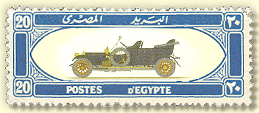

|
After leaving their native New Zealand and serving in the British Army during World War I, the Nairns decided to set up a business in the Middle East selling automobiles. However business did not take off as hoped so they opened a taxi service of 112-kilometer journey (70-miles) between Beirut and Haifa. Their taxis cut the travel normal transportation, which was still largely dependent on camels and other beasts of burden from three days to a day and soon a daily schedule was implemented and the service extended to Damascus.
Norman Nairn proposed to British officials in Baghdad that he and his brother provide a regular mail service between Damascus and Baghdad. He pointed out that by using the desert track the normal time for mail deliveries between India and Great Britain could be cut down to nine or 10 days instead of the customary six weeks needed to send mail by ship through the Suez Canal - by linking the overland route to the arrival of ships at Port Said. British officials in Baghdad were sceptical, and so were the French authorities in Damascus. But the French government eventually approved the idea after all - even agreeing to provide a subsidy in gold to pay desert tribes for a guarantee of safe passage across the desert - and the Nairns, as a result, signed a contract to carry mail between Haifa and Baghdad on a weekly basis for a period of five years - and that the time for the journey should not exceed 60 hours. For every hour in excess of that limit, a fine would be imposed. This clause in the contract never had to be invoked. On October 18, 1923, just a little over six months after the first exploratory trip, the mail service was officially opened their service with the first run being a resounding success. After a while passengers were also carried As the Nairns' enterprise prospered, competition was inevitable, and one company, owned by the Beirut brothers Francis and Alfred Kettaneh, began to offer passengers the chance to see Palmyra when travelling between Damascus and Baghdad. The Nairns responded by cutting their time to a little over 24 hours. By 1926 the Nairns were operating six-ton, American-made Safeway buses capable of carrying 16 passengers in comfortable, high-backed seats and almost two tons of luggage. With two drivers - which enabled the buses to drive at night too - the Naims found they could reduce the crossing time to 20 hours. By 1934, the Nairns the business and was using new vehicles called Aerocars, Buick coupes towing small coaches capable of carrying 10 passengers. They also added a four-wheeled American Car Foundry coach capable of carrying 24 passengers and fitted with reclining seats as well as what was then the biggest bus in the world a Marmon-Harrington 38-seater powered by a l50-horsepower tractor driven off three axles. This 21-meter-long vehicle (70-feet), purchased in 1933, weighed 26 tons and gave passengers a smooth ride in seats modelled after those used in passenger airplanes. Riders also enjoyed such amenities as a buffet, a toilet and packed lunches. In 1936, the transport company entered its last and most prosperous phase, a period that coincided with, and partially developed from, the rapidly growing importance of oil in the Middle East. Under the Vichy French during World War II the Nairns had to endure some lean years, but in the period immediately after the war, the Nairns' company flourished. But in the post-war period the company began to decline as air transport developed, and political difficulties increased. By 1950 the Nairns had had enough; they handed over the company's shares to the employees. The initial Iraqi mail contract for a five years term with post being carried at the rate of lsh6p per pound. The mail termini were Baghdad and Port Said via Haifa from whence mails would proceed by rail the weekly service was scheduled to connect with service of the Anglo - Indian Steamers at Port Said and later with mail carrying ships at Beirut Harbour.  At the start mail was meant to be inscribed by the sender 'OVERLAND MAIL' in red ink and in 1923 Egypt issued at white on red label. 27mm x 19mm they were produced in a 6x12 sheet and given free of charge. A surcharge of 5mil per 20g for letters to Lebanon and Syria and 15mil per 20g for letters to Iraq. On March 27, 1924 Iraq also started issue their own labels.
At the start mail was meant to be inscribed by the sender 'OVERLAND MAIL' in red ink and in 1923 Egypt issued at white on red label. 27mm x 19mm they were produced in a 6x12 sheet and given free of charge. A surcharge of 5mil per 20g for letters to Lebanon and Syria and 15mil per 20g for letters to Iraq. On March 27, 1924 Iraq also started issue their own labels.
As the air route became established the motor mail surcharge was cut 3mil/50g but the service was dropped sometime around the mid thirties. Few covers seem to have survived and the majority of these are for the western direction from Iraq and those with the Egyptian less then twenty have been noted. Extracts from the Journal Officiel (as published in QC 139) |
 A pre-label cover with one of the handstamps used |
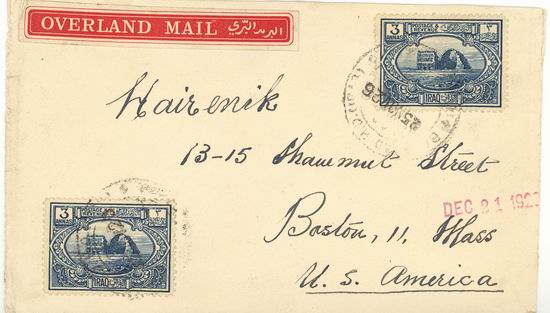 One of the Iraqi labels. |
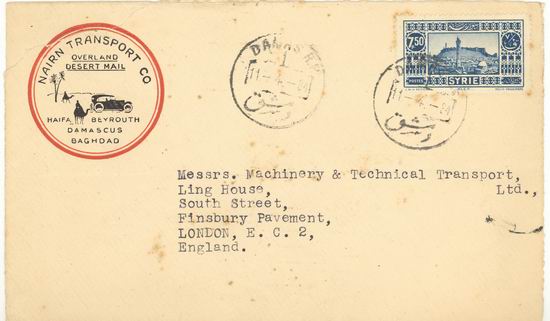 The Nairn transport company had several envelopes printed with varying logos. |
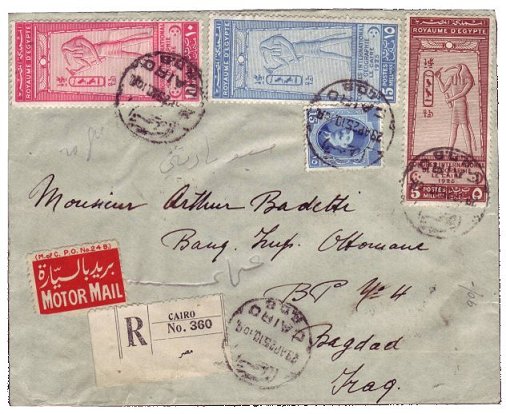 Correctly used Egyptian motor label. |
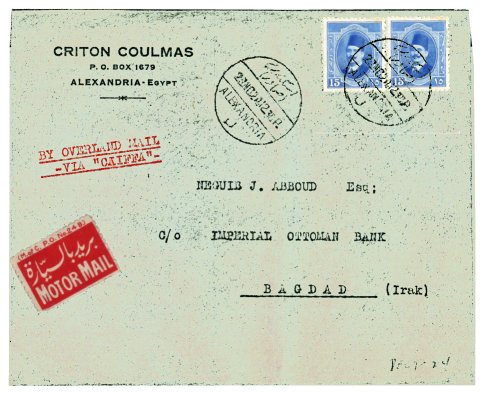 Correctly used Egyptian motor label. |
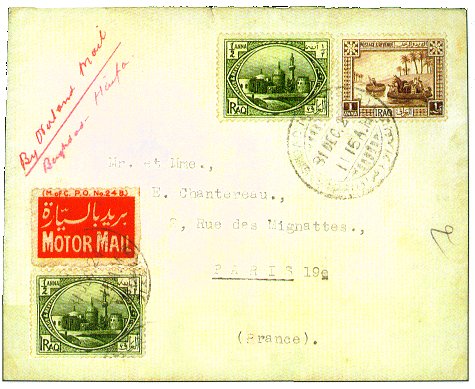 Of the known covers with the Egyptian label three were used in Iraq for west bound letters. |
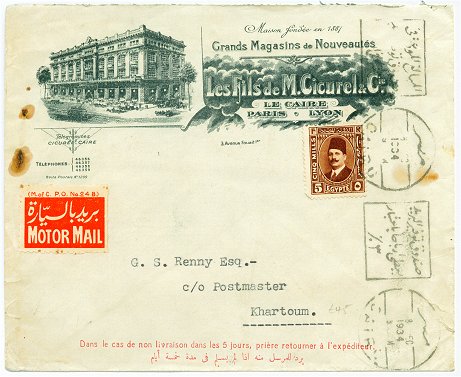 There was no equivalent special overland route to the Sudan so way the label? The cover is back stamped Khartoum so has travelled through the post. Was the sender unaware this label had no meaning for post to Sudan or was it done philatelicly. It could have possibly stuck on years after the letter was sent but if intended to deceive why chose a cover sent to the Sudan? |

|
|